Page 1 of 1
Adjustable suspension
Posted: Thu Jul 19, 2007 9:53 am
by -Richo-
I was discussing with my good mate Gribble last night the benefits of adjustable suspension. We got talking about off camber situations as well as steep, almost verticle inclines and what effects adjustable suspension would have on the vehicle. Now i tend to deal with engineering solutions by comparing them to other realistic examples, for instance when walking sideways along an incline (off camber) you tend to lean your body towards the high side to aid in stability. Which leads me to think that in the same situation in a 4b with adjustable suspension, jacking up the low side will shift the sprung weight towards the high side increasing stability. Gribble disagrees saying that the centre of gravity will be shifted higher, but towards the low side therefore decreasing stabilty.
Also from experience i have found that a 4b that articulates well tends to be more stable (when set up right anyway), which also leads me to think that forced articulation would increase stabilty in certain situations.
We also discussed driving up almost vertical inclines, i believe that jacking up the rear would decrease your chances of back flipping by increasing the angle at which the vehicle is pointing up hill, Gribbles says that by doing that the COG is being tipped further back and therefore increasing the likelyhood of back flipping. I would think jacking up the front would do this. Ill let Gribble explain his reasoning.
I can understand the engineering principles that Gribbs put forth in his arguement, but it seems to fly in the face of what i have seen and experienced in the real world.
I always thought that the above situations were one of the main reasons for bothering with adjustabe suspension in the first place other than being able to increase ramp over.
Anyway, discuss

It will be good to hear from people that have adjustable suspension set ups and to tell of their real world experiences of what does and doesnt work.
Posted: Thu Jul 19, 2007 10:22 am
by Gwagensteve
I will write a longer reply when I am at home not trying to look busy at wirok, but htis is a really interesting topic.
In short, IMHO, the effect of shifting the COG higher will depend on how the suspension is adjusted (i.e does one side raise only, or does one side lower and the other raise) and the roll centre of the vehicle.
I love this sort of thread - nice work!
Steve.
PS I have not had adjustable suspension per se - it would be good to get maybe the Christies, Antunac or Dobbin's thoughts on this.
Posted: Thu Jul 19, 2007 10:38 am
by RO8M
Temper this reply with the fact that I am fairly noob to mod fourbees, but am a mech design engineer (in the food industry, but none-the-less..)
ANYHOW, i tend to agree with you, Richo, in the theoretical, but this would be limited ( i would think) by the line/arc/locus of wheel travel when forcing articulation.
Example:
Travelling along the side of hill, left is downhill, right is uphill. You want to move your left wheels down VERTICALLY, which would be an arc/line that actually angles down and away from the vehicle body. If you articulated your axles about the uphill wheel (no IFS/IRS) then you are moving the left wheels down relative to the body, but actually moving them to the RIGHT as well when viewed from outside the vehicle, thus moving your footprint closer to the CoG.
Have I explained that clearly? Hands up those who have another perspective?
Posted: Thu Jul 19, 2007 12:19 pm
by Hekta
Have a quick read through Bentzook's thread

Posted: Thu Jul 19, 2007 12:29 pm
by 1MadEngineer
ok, thoughts from someone that has real world experience in this!!
we have had hydraulic adjustable suspension on BB's lux for nearly 3 years now, so i have got a good idea of what works and in what situation. We never use the hyd when straight climbing or any offcamber situation (except to miss a cone, but then drop it down) it raises the Cof G and makes it more unstable. We do however use the rear once the front is on top of big ledges and we are suffering from breakover issues due to the rig being so low in the first place.
We do use the diff winchs way more than the hydraulics!!!
Posted: Thu Jul 19, 2007 12:57 pm
by Gribble
[deep philosophical engineering talk=on]
To best understand my viewpoint on this we need to first start at the most basic pricipal in stability, the "Stability Triangle". Engineering minded people will already understand this, but ill explain anyway.
Here is a very crude paint drawing of a car, this basic rule can apply to any car, it can be a troopy, patrol, or one of those hillman gimps even. For the purpose of this explanation its just a car.
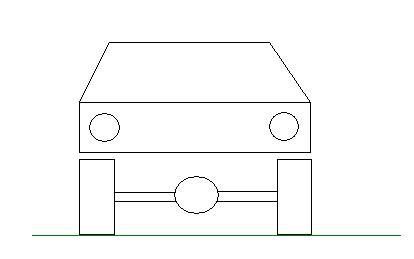
Now lets add the "Stability Triangle" to the car. The pivot points, or fulcrums at which the vehicle will roll around are the outer edges of the tyre. Lets assume that the distance between outer edges of the left and right tyres is excactly 2m. Also we will assume that the COG of the car is in the dead centre between the outside edges of the tyre and excactly 1m from the ground. The weight of the vehicle is 1 metric ton.
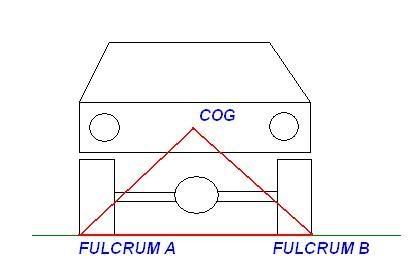
Lets add the weight component of the car to the triangle now. There are no external factors that are affecting this component, such as cornering forces, acceleration or braking. So the weight off the COG is dead vertical, the only force affecting it is gravity (the first layer anyway).

Now because we have 2 right angle triangles making up the stability triangle the angles at the fulcrums are both 45 degrees. If we were to tilt the car over the the left 45 degrees the left hand side of the triangle is now vertical. Like this......
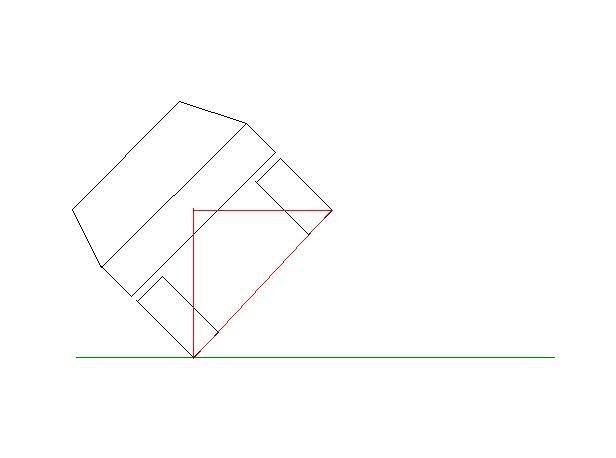
Now the position of the COG relative to the car hasnt changed, its still in the same spot. The vehicle has no suspension travel and its wheels magically do not deform, so the triangle remains the same dimensions and moves in perfect unisen with the car. Now we add the weight of the car to the COG. Because gravity is perpendicular to the horizontal ground it swings much like a pendulum hanging from the top of the triangle as the vehicle rolls to its side, the force is still acting on the COG. Now that the left hand side of the triangle is vertical it is also totally parralell to the weight component acting on the COG. In a perfect world the vehicle would now be perfectly balanced on its side.
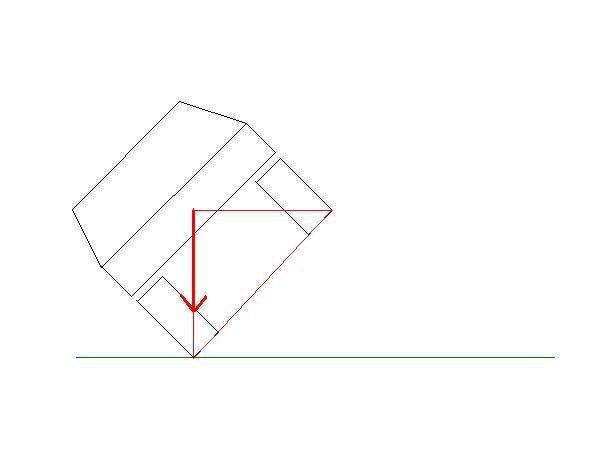
Im going to now just draw the triangles because by now you should know where the corners are on the car. This last picture demonstrates what would happen if you were to tip the car further to the left or further to the right.
Further to the left and the weight component arrow is now OUTSIDE this triangle, because there is no external cornering, braking or acceleration force the vehicle is now going to begin to roll over to the left. In the other drawing you can see that the weight component arrow is still inside the triangle. Again, no corning, braking or acceleration exists so this vehicle will roll back until both wheels hit the ground.
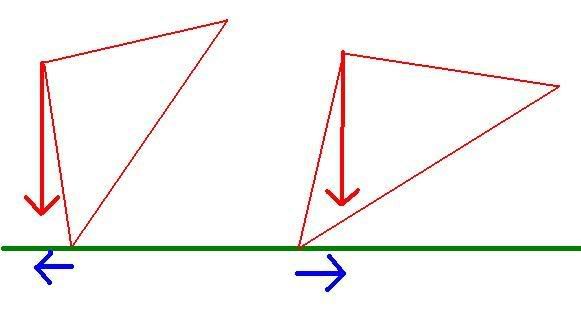
Ive got to get back to work now, so I will further my explanition when I get home from work when I will add other factors like cornering, raising and lowering the suspension and other things that will be going on in a more dynamic sense.
[/deep philosophical engineering talk]
My brain hurts.

Posted: Thu Jul 19, 2007 1:47 pm
by Gwagensteve

Steve.
Posted: Thu Jul 19, 2007 2:36 pm
by Dee
Gribble wrote:[deep philosophical engineering talk=on]
So the weight off the COG is dead vertical, the only force affecting it is gravity
(the first layer anyway).
[/deep philosophical engineering talk]
My brain hurts.


Posted: Thu Jul 19, 2007 3:38 pm
by me3@neuralfibre.com
You could get really tricky. I've been thinking for a while that if you could get your COG below the suspension roll centre, then the body should roll into a corner rather than out. Same would apply for a hill. That said, they dynamics of thsi balance are harder than my brain can do offhand.
Paul
Posted: Thu Jul 19, 2007 3:52 pm
by Gwagensteve
If this was practically possible it would have been done a long time ago. Think about a kid on a swing. The COG is well below the roll centre, but high loading (if the kid is really swinging on the swing - similar to cornering load) will make the swing kick over quite violently if it's not retained.
I haven't really expressed this properly and don't have the time now to answer in a more detailed way (or match Gribbles drawings)
Steve.
*edit* Actually, the big problem with this is that ina by functional vehicle this would result in raising the roll centre heaps - maybe by up to 700mm, which is counterproductive for pretty much all vehicle behaviour.
I think that GOG should be as low as possible and roll centre should also be as lot as reasonably achievable. Raising either is couterproductive.
steve.
Posted: Thu Jul 19, 2007 8:27 pm
by -Richo-
1MadEngineer wrote:ok, thoughts from someone that has real world experience in this!!
we have had hydraulic adjustable suspension on BB's lux for nearly 3 years now, so i have got a good idea of what works and in what situation. We never use the hyd when straight climbing or any offcamber situation (except to miss a cone, but then drop it down) it raises the Cof G and makes it more unstable. We do however use the rear once the front is on top of big ledges and we are suffering from breakover issues due to the rig being so low in the first place.
We do use the diff winchs way more than the hydraulics!!!
Hmmm interesting, winching the diff down would be better than jacking up the low side it seems, i just figured they would be achieving the same thing, but of course when lifting the suspension rather than pulling it down, the CoG is going up no matter what you do.
It would be good to hear from Chad or Mr Antenac running dobbins set up to see if they use it in this manner.
If such a system only achieves an increased ramp over angle, i cant see it being worth the trouble, 2 winches with a higher ride height would be more effective (and cheaper)

Also here is a good pic of what im talking about...

Posted: Fri Jul 20, 2007 9:05 am
by 1MadEngineer
-Richo- wrote:1MadEngineer wrote:ok, thoughts from someone that has real world experience in this!!
we have had hydraulic adjustable suspension on BB's lux for nearly 3 years now, so i have got a good idea of what works and in what situation. We never use the hyd when straight climbing or any offcamber situation (except to miss a cone, but then drop it down) it raises the Cof G and makes it more unstable. We do however use the rear once the front is on top of big ledges and we are suffering from breakover issues due to the rig being so low in the first place.
We do use the diff winchs way more than the hydraulics!!!
Hmmm interesting, winching the diff down would be better than jacking up the low side it seems, i just figured they would be achieving the same thing, but of course when lifting the suspension rather than pulling it down, the CoG is going up no matter what you do.
It would be good to hear from Chad or Mr Antenac running dobbins set up to see if they use it in this manner.
If such a system only achieves an increased ramp over angle, i cant see it being worth the trouble, 2 winches with a higher ride height would be more effective (and cheaper)

Also here is a good pic of what im talking about...

that pic is an excellant example of when NOT to use the hyd!!!(he is even having to hold the car off the bunting) When we drove that section of the track i ran straight past and just let BB drive through i had no concerns ever about it offcamber (i think the rear winch might have been pulled in a little) .
 It will be good to hear from people that have adjustable suspension set ups and to tell of their real world experiences of what does and doesnt work.
It will be good to hear from people that have adjustable suspension set ups and to tell of their real world experiences of what does and doesnt work.





